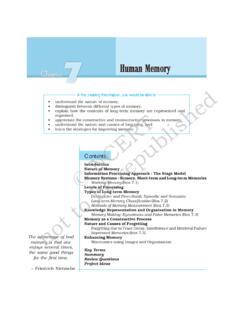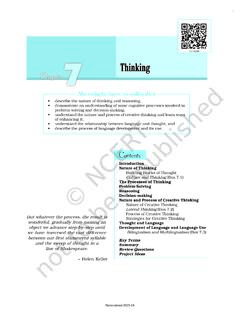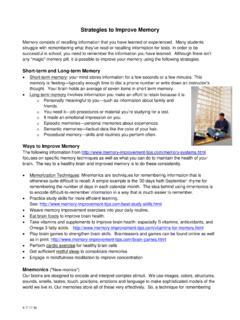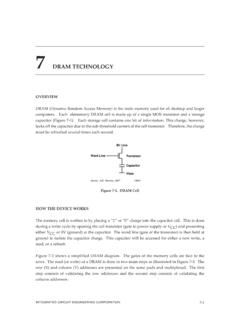Transcription of Continuous Quality Improvement (CQI)
1 Continuous Quality Improvement 9-1 Step 9 Continuous Quality Improvement (CQI) Contents Materials .. 9-2 Step 9 checklist .. 9-3 FYN tackles Step 9 .. 9-3 Reasons for conducting CQI .. 9-4 Information to get you started .. 9-6 How to implement a CQI review .. 9-8 Prepare the review .. 9-8 Complete the review .. 9-9 Applying Step 9 when you already have a program .. 9-17 Sustainability at this stage .. 9-18 Lessons learned .. 9-18 Getting ready for Step 10 .. 9-20 ** Focus question How will we continuously improve the Quality of the program?
2 Step 9 CQI takes you through an intentional process of discovering what can be improved so that things work even better the next time you offer this or another teen pregnancy prevention program. Of course, we hope that most things turned out the way you thought they would, demonstrating good processes and outcomes. Even so, you probably discovered that some things didn t turn out as you d hoped. We ve based the tasks in this step on a common business strategy called Continuous Quality Improvement (CQI). CQI takes what you ve learned as you evaluated your planning, implementation, and outcomes and then applies it to the Continuous Improvement and growth of your programming.
3 It s a simple, 9-2 Continuous Quality Improvement but systematic work review to see what changes you could make to improve your program the next time around. It means, simply, that you constantly collect and use information to make adaptations to your program so that it works better over time. Although CQI can be used to identify areas in need of Improvement , it s more than just a process of finding and fixing problems. It shows you what s working well so that you can build on it and repeat your successes. Asking questions, discussing the possible answers, reaching agreement, and communicating decisions are all part of a cyclical, healthy, and useful CQI process.
4 CQI also helps build the sustainability of your program. The more you can repeat your successes and improve the planning, implementation, and evaluation of your program at every stage, the more you increase your chances of sustaining your work on a number of levels. Engaging in an on-going CQI process keeps you current and responsive to changes going on around you and within your organization. Being responsive and adaptable is important to keeping your good work going. Materials You ve probably already compiled all of the materials you will need to do a CQI review in your three-ring binder.
5 Completed Step 1 Resource Assessment and Priority Needs Filter tools Completed Step 2 BDI Logic Model and SMART Desired Outcomes tools Completed Step 4 Program Fit Assessment tool Completed Step 5 Capacity Assessment tool Completed Step 6 work plan, Work Plan tool, and Culturally Appropriate Programs Checklist Completed Step 7 Process Evaluation showing successes and challenges of delivering your program Summaries of staff and participant satisfaction surveys (if performed) Completed Step 8 Outcome Evaluation and data summary from fidelity monitoring To complete this step, you ll need: Copies of the Step 9 CQI Results tool on the CDC Teen Pregnancy website Continuous Quality Improvement 9-3 Step 9 checklist Upon completing Step 9, your organization will have conducted CQI assessments of your work and come up with an associated plan for Improvement .
6 Document successful program activities Assess program activities that did not work well overall or for specific groups Identify areas for Improvement Create strategies for Improvement Increase buy-in within your organization by soliciting and acting on the suggestions of program staff FYN tackles Step 9 Before FYN implemented and evaluated MPC for the first time, the work group already knew they wanted to conduct a formal Continuous Quality Improvement review of everything they had done so far. They hoped that a CQI review would show what had worked well, what had not worked out as planned, and where FYN could make improvements the next time they ran MPC.
7 Led by the FYN program director, the adult and youth facilitators, FYN staff and administrators, and work group members met to review how things had gone. They drew upon the materials saved in their three-ring binder, including program information and evaluation results, and walked through the CQI Results tool together. 9-4 Continuous Quality Improvement Reasons for conducting CQI Programs that are implemented multiple times are frequently subject to some kind of review to ensure that the intended benefits are still being achieved.
8 Funders want evaluation results to demonstrate that their funds are well spent, and those involved with implementing programs want to know they are having the desired impact. Even if adequate resources exist to thoroughly study the impact of programs, however, very few get all components correct the first try. Continuous Quality Improvement (CQI) is one important aspect of evaluation that can be used to improve a repeated program s effectiveness. You have already done a short form of CQI by performing needed midcourse corrections during the implementation.
9 You now have an opportunity to make more substantial improvements in program performance before you repeat it. We sometimes call this strategic CQI because it involves a broader approach to Improvement . Being conducted after a round of your program has been implemented, strategic CQI is also a great opportunity to learn from previous implementation efforts in which program processes and outcomes were well documented (Wilson et al. 2009). Benefits to the program Document program components that worked well. Tracking success helps to ensure that future implementations also will be successful.
10 Assess program components for elements that did not work well. Recognizing weaknesses and failures helps to clarify improvements you can make. Support program staff by obtaining and using feedback. Useful critique promotes growth and an increasing ability to produce more effective programs. Benefits to the organization Support staff and organizational values. CQI is the right thing to do for those interested in offering the most effective services possible for their clients. Participating in CQI activities can also energize people by reflecting on their work and having input into programming moving forward.
















